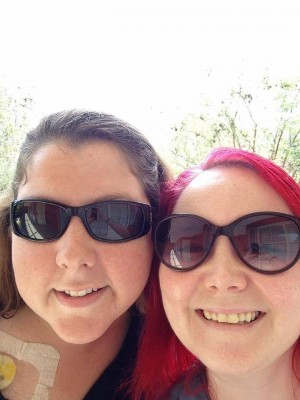Love and rainbows
A friend of mine died yesterday. We never met in person, and shortly after we began talking, she found out she was dying. We met through the mast cell community, but she was living with something far more insidious – a rapidly progressing, heritable form of ALS. She died a little over a year after being diagnosed. She is survived by her husband and young son, and many close friends and relatives.
I found out that she was dying yesterday through Facebook. She posted herself that it would be her last day, as she had chosen to invoke Oregon’s Right to Die. I scrolled through all the supportive posts on her page, all the pictures of her with her close friends, recipes she had left for her son.
I learned a lot from her about grace and how to die a good death. Her openness about her illness, and about the ways her body has failed her personally and those in her life in a larger sense, has been a constant source of solidarity for me. She truly embodied the fact that you can love your life and be truly alive even while your body is becoming incapable of sustaining life. She really taught me that life has very little to do with the things you can do and more to do with feeding the relationships you have. I am grateful to have known her.
Every day, I see articles and posts advocating for people to “turn off the screens” and “connect for real”. If it’s not in front of you, if you can’t touch it, it’s not as worthy of your attention, it seems these people think. If you have a conversation via text message, it doesn’t mean as much as one across a table. One of these posts was in my Newsfeed right below Sherrie’s post that was leaving this world today. I shook my head.
These people who write these things don’t know what it means to have a rare disease. They don’t know the loneliness you feel every day surrounded by people who don’t know what it’s like to live in a body that can go into shock without any provocation. They don’t know the overwhelming sense of belonging you feel when you find someone online like you. They don’t know that having someone say, “I understand, I’m the same way,” in a group online can sustain you and validate you just as much as any in person interaction ever will. It is connecting for real, and it’s not less because it happens online.
Sherrie believed that when she died, she would go back up the rainbow she slid down when she was born. She surrounded herself with rainbows, and it became a metaphor for her larger experience. Some weeks ago, after a few difficult days, she wrote the sentence, “The rainbow is calling me.” I shivered when I read it. I can’t believe that the courage and surrender embodied in these few words are less important because I didn’t hear them in person. That’s not how the world works.
What we are doing here, in this community, matters. Supporting each other and understanding each other matters.
When the harder days come, I will remember Sherrie and that life has very little to do with our bodies. It has to do with love and rainbows.
